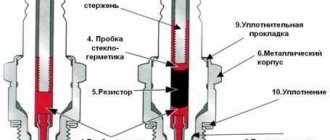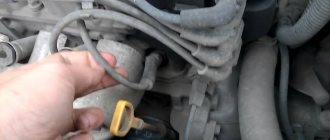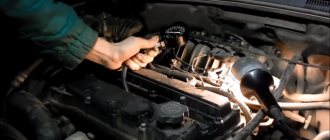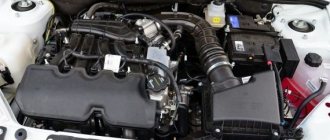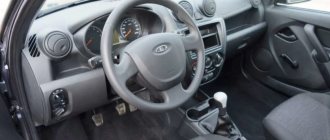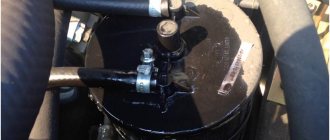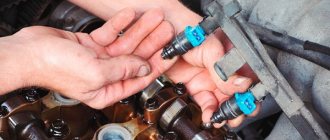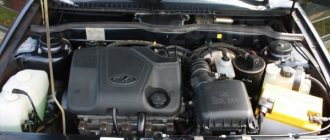Maybe not all, but many motorists are faced with this problem: yesterday I arrived, put the car in the garage, everything was fine. This morning I started to start the engine, but it would not start.
There could be a number of reasons for this. But today we will look at the most common one - filling the spark plugs with gasoline, it doesn’t matter whether you have an injector or a carburetor. Fills spark plugs with gasoline regardless of the type of fuel system of the car.
It is characteristic that the spark plugs are filled with gasoline less often in the warm season, and more often at sub-zero temperatures. So let’s try to figure out in order: why the spark plugs in the injector are flooded, what to do to start the engine at the exact moment when they are flooded, and how to prevent them from being flooded with gasoline in the injector.
Reasons why the spark plugs in the injector flood
Calcination of spark plugs filled with gasoline
In principle, the reason why the injector spark plugs flood is simple. And the tones lie in the peculiarities of the “electronic brain” of your car.
At subzero temperatures, mixing the fuel-air mixture requires some effort: more oxygen in cold air requires more gasoline. Accordingly, the ECU gives a command to the injector nozzles to increase the fuel supply, which they do in good faith.
And the following happens in the engine, especially if your car no longer has a new battery. The injectors supply fuel to the combustion chamber, the starter tries to create the necessary compression in the cylinders, while at the same time trying to provide a spark to generate a flash. Do not forget about the quality of fuel, which does not have ideal parameters.
As a result, with ideal compression, the injector spark plugs can start even with a minimum impulse, but ideal compression is only found in a new car. Actually, this is why, as a rule, the injector spark plugs of a new car do not fill.
The spark is weak, compression in the cold does not correspond to the parameters, and the injectors continue to supply fuel to the combustion chamber. Which, in turn, floods the candles and they simply stop showing signs of fiery life.
This is the answer to the question - why are they filled in on the injector?
What to do if the spark plugs on the injector are filled with gasoline
There are two options for resolving the issue. As a rule, the “smart” operating book says: if the injector spark plugs are filled with gasoline, you need to unscrew them and dry them. With the spark plugs removed, crank the starter for 10-15 seconds. Put it back in and start the engine. These are actions according to the manufacturer.
A proven popular driving method. If your spark plugs are filled with gasoline, before unscrewing and drying them, try to start the engine in the following way: purge mode.
For the injector: the gas pedal is pressed all the way to the floor. Use the starter to crank the engine for 10-12 seconds, release the gas pedal. The engine should start. The fact is that in this way, by cutting off the fuel supply, you blow air through the spark plugs.
The engine did not start. Then try to dry them. Spark plugs for an injector are, in principle, no different from a carburetor engine. Therefore, we again use the “old-fashioned” method: we unscrew them, clean them from carbon deposits with a metal brush, or a toothbrush, and dry them either with a hairdryer, or on a gas stove or in the oven. We check the gap and screw the spark plugs for the injector into place. The engine should start.
For used cars, the recommendation of experts is to clean the spark plugs more often, or even better, replace them.
If the story of filling the spark plugs with gasoline repeats itself every morning, you need to carry out diagnostics: spark plug quality, injector cleanliness, spark output from the ignition coil, Hall sensor.
Conditions under which the spark plugs will not fill with gasoline
Naturally, these are ideal conditions, but you can control many of them so that you don’t have to meet the morning in a minibus while going about your business.
So, the main conditions are:
- a well-charged battery and a working starter,
- high-quality oil with appropriate parameters for the cold season,
- spark plugs and high voltage wires are of high quality and in good condition,
- the injector nozzles were promptly cleaned and adjusted. Preferably not with the help of various additives to the tank, but with the use of equipment for cleaning injectors,
- high quality gasoline
People's advice: if you want the engine to start normally in cold weather and the spark plugs not to be filled with gasoline, the engine needs to be “twisted” periodically, once a month. Distance 50-100 km. at a car speed of 100-120 km/h and on good fuel.
Or once every two days, while driving, give the engine a load of up to 4500-5000 rpm for 10 seconds so that self-cleaning of carbon deposits and deposits in the chamber occurs.
As you can see, these conditions are easy to control yourself, without the help of car service specialists.
Fills candles with gasoline: reasons
The injector fills the spark plugs with gasoline due to the characteristics of the engine control unit. It is usually clear why the spark plugs on a VAZ 2110 or any other similar car flood during frosts. Going forward, we can say that the main reason why spark plugs are filled with gasoline is negligence and a discharged battery.
In order for the engine to start in cold weather, the engine control unit needs to supply more gasoline to the combustion chambers, because there is more oxygen in cold air, so more gasoline is needed. As a result, more fuel mixture is obtained, and the car usually drives more quickly if everything works well.
The engine's electronic control unit gives a signal to the injector nozzles to increase the fuel supply. They usually cope with this normally, if they work properly.
But if your battery is far from new, and in the cold the battery discharges faster, then a situation may occur in the engine when the injectors drive gasoline into the combustion chamber, and the starter creates the necessary compression in the cylinders, at this moment a high-quality discharge must appear for it to occur. flash. Also, a lot depends on the quality of the fuel, and high-quality fuel does not exist in nature in Russia.
As a result, it turns out that if the engine has ideal compression, and this only happens in a new car, then the injector spark plugs will be able to start the engine with the minimum permissible impulse. And if the car is not new and the battery has also become weak in the cold, then eventually the spark plugs will give a weak spark, and the injectors will supply fuel to the combustion chamber at full capacity, so the spark plugs will begin to flood, and they will finally stop giving a spark. This is why the injector floods the spark plugs because the battery is discharged. Therefore, if you have flooded the spark plugs in your VAZ 2114, then you know why this happened, and now we’ll find out what to do about it.
Filling spark plugs on a VAZ 2109 carburetor? You are not alone. The problem is solvable
You don’t know what to do because the carburetor on your VAZ 2109 is flooding the spark plugs?
Then this recommendation article is clearly for you. As they say: whichever car you buy, it will be either a test or a pleasure. We can quite agree with this, but everyone chooses according to their financial abilities. And this is the main criterion. Therefore, if you purchased a domestic Mercedes in the form of a VAZ 2109, do not be upset, because this is temporary, and later you will exchange it for another brand. Of course, if you don’t adhere to the opinion, the basins are knocked down.
I don’t want to offend our manufacturer, but cars 15 years ago are not famous for their excellent quality
, because they are a little “damp” and unfinished. And with the onset of autumn and winter, for the nine, real tests begin: sub-zero temperatures, constant starts and stops, a disgusting road (or rather, its complete absence).
It is during this period that spark plugs are especially vulnerable, because of them there are a lot of problems, and the very first one is “filling” with fuel during a cold start. Further movement is not possible.
Studying plaque on candles
They say that when candles are “flooded,” black soot forms. Let us clarify: it should not consist of inclusions. All metal, in turn, will be covered with an oily coating. Dry carbon looks different...
Oily layer and dry soot
We recommend: How to properly remove the engine block head?
The photo shows two cases. “Our version” is on the right.
And soot can also be brown. And it always, in 100% of cases, is formed due to flooding with gasoline.
Dark brown soot
An oily coating, as in photo 1, is, nevertheless, the result of oil ingress. But an oiled candle does not work correctly - it will also be “flooded”.
With regular “flooding,” carbon deposits form, which we see in photo 1 on the right and in photo 2. The rest does not apply to our case.
The engine does not start in cold weather, reasons
But flooding of spark plugs, unfortunately, is not the only factor that negatively affects the engine starting procedure at low temperatures. Every car owner should know about the most common of them - familiarity with the cause of problems of this kind often allows one to prevent the very possibility of their occurrence.
Problems with flooded spark plugs can occur when purchasing and installing a low-quality product. What we can recommend to car enthusiasts is that you should not choose consumables and spare parts for your car based on thoughts of maximum savings; purchasing a quality product at a higher price can often save you from many problems that arise during operation.
Flooding with gasoline can also occur due to a high degree of wear on the spark plugs.
A weak spark can also occur if the spark plugs are heavily contaminated with carbon deposits, but the spark produced from them is not able to ignite a cold fuel-air mixture that does not contain flammable vapors.
The solution is to timely clean the spark plugs from soot, and, if necessary, replace them with new ones of appropriate quality.
High-voltage wires are damaged, how to check and fix them
You can also fill the spark plugs with gasoline if the high-voltage wires are damaged. The reason is that faulty wiring can produce an uneven spark.
poor quality fuel
The quality of the fuel is a very important factor on which the evaporation process depends. Practice proves that even at normal temperatures some types of fuel do not exhibit normal combustion; there is no need to say that at subzero temperatures they will evaporate and ignite.
Experts recommend paying attention to the quality of the fuel your car is fueled with and its suitability for the season. For use in the cold season, you should give preference to gasoline with the maximum octane number allowed for your car engine.
A positive result can be obtained by using the winter type of gasoline offered in your region. Such fuel ignites much more easily, even in severe frosts.
malfunction of the power system, how to check and fix it
Difficulties in starting a cold engine can also be caused by faults in the power supply system. A negative impact is caused by clogged or worn injectors, which, as a result of existing defects, can supply the wrong amount of fuel. Naturally, such violations will cause the candles to burn out.
To eliminate the problem, it is recommended to systematically monitor the condition of the engine components and systems, and eliminate any deviations noticed in a timely manner. Maintaining the power system involves regular cleaning and adjustment to the recommended settings.
We should not forget about the need to properly charge the battery - otherwise it will supply a voltage that is insufficient to produce a spark at startup.
Carburetor overflows
“Overflow” on carburetors 2108, 21081, 21083 Solex and 2105, 2107 Ozone in VAZ cars 2108, 2109, 21099, 2105, 2107, etc. is a fairly common phenomenon.
“Overflow” is a strong over-enrichment of the fuel mixture entering the cylinders of a car engine, due to one or another malfunction of the carburetor and/or fuel system of the car. Sometimes even with the naked eye you can see how fuel leaks from the diffuser nozzles at idle, while a persistent smell of gasoline reigns under the hood.
Signs that the carburetor is overflowing
If the carburetor “overflows,” then quite often it is simply impossible to start the car engine (especially a warm engine); there are unstable or increased idle speeds, which often cannot be adjusted. When the engine is running, black smoke comes out of the muffler - a consequence of excess fuel burning out in it. “Disruptions” are possible when you press the gas pedal - as the rich fuel mixture floods the spark plugs. And the candles themselves are covered in black soot or even wet. The exhaust pipe of the car muffler smells of gasoline.
Reasons for carburetor overflow
First of all, when there is “overflow” on carburetors 2108, 21081, 21083 Solex, 2105, 2107 Ozone of VAZ 2108, 2109, 21099, 2105, 2107 carburetors, you should pay attention to the operation of the float chamber:
— The needle valve is faulty (not sealed)
In some cases, it may simply “hang” in the open position (sometimes this can be treated by lightly tapping the carburetor cover with a hammer). You should also pay attention to how tightly the needle valve body is wrapped and the presence of an O-ring under it. The needle valve is checked by applying a vacuum to it.
Valve Inspection Articles:
Checking the needle valve with vacuum on carburetors 2105, 2107 Ozone, 2108, 21081, 21083 Solex
— “Broken” (not sealed) float
It drowns in gasoline and pulls the shut-off valve needle with it. It turns out that the needle valve is constantly open and gasoline is pumped freely into the float chamber. You should remove the float, shake it over your ear and determine by the sound whether gasoline is splashing in it or not. A “broken” float can be soldered, but it is better to replace it with a new one.
Carburetor floats 2108 Solex, 2105, 2107 Ozone
— The float touches the walls of the float chamber
Its position relative to the walls of the carburetor float chamber is disturbed. Remove the carburetor “cover” and look at the position of the float relative to the imprint on the cardboard gasket. Everything must be in parallel. Along the way, we check the ease of its movement, the levers and racks for deformation and distortion.
Aligning floats on carburetors 2105, 2107 Ozone, 2108, 21081, 21083 Solex
— Fuel level in the carburetor float chamber is too high
Remove the top part (“cover”) of the carburetor and check the fuel level in the float chamber. On carburetors 2105, 2107 Ozone level is in the middle of the inclined plane of the front wall of the float chamber. On 2108, 21081, 21083 Solex 29±2 mm to the bottom of the float chamber.
Fuel level in the float chambers of carburetors 2108. 21081, 21083 Solex, 2105, 2107 Ozone, after removing the cover - shown by the red line
If there are any deviations, we adjust the fuel level:
In addition to problems with the float chamber, other elements of the vehicle's power system may also be the cause of fuel overflow.
— Fuel pump is faulty
There is its increased productivity, due to which excess fuel is pumped into the float chamber. This is especially true for VAZ 2105, 2107 cars, where there is no return line and nowhere to dump excess fuel. Check the serviceability of the fuel pump: its valves, return spring diaphragm.
Main elements of the fuel pump for VAZ (DAAZ) cars
— The fuel drain line to the carburetor (“return”) is faulty
Only for carburetor 2108, 21081, 21083 Solex. The “return” may be clogged, deformed, or the check valve built into it may be faulty. With this malfunction, it becomes difficult to dump excess fuel back into the gas tank and it goes into the float chamber and then into the engine cylinders. It is necessary to visually inspect the return line for damage and blow it and the check valve in the direction from the carburetor to the gas tank.
“Return” and check valve of carburetor 2108, 21081, 21083 Solex
— The rubber o-ring on the fuel channel of the idle system is damaged or missing
(for Solex carburetor)
In this case, fuel leaks out from under the cardboard gasket. The carburetor may be leaking fuel. Remove the top of the carburetor, check the presence and integrity of the rubber O-ring.
Rubber sealing ring on the connecting tube of the fuel channel of the carburetor 2108, 21081, 21083 Solex
— The economizer of the carburetor power modes is faulty
(only for carburetor 2108, 21081, 21083 Solex)
If the diaphragm in the economizer body is damaged, the fuel, which is not restrained by anything, flows through its channels under the influence of vacuum into the second chamber of the carburetor. The same situation occurs when the economizer valve ball sinks.
Why are the candles flooded?
Let's first look at the reasons why the spark plugs on the injector are flooded. To do this, consider the operation of a car starter.
Thanks to the operation of its pistons and valves, a mixture of gasoline and air is supplied to the combustion chamber, which is ignited by a spark generated by the spark plugs. After ignition, the starter turns off. Thanks to ignition, the engine cylinders start working. To successfully start the engine, you need a working starter, a powerful battery and a favorable ambient temperature.
At low temperatures, gasoline does not mix well with air. It is known that frosty air contains more oxygen. An increase in oxygen content requires the supply of more gasoline. The vehicle's electronic control unit sends a signal to the fuel injectors, which increases the fuel supply. Thanks to the starter, compression is created in the cylinders and at the same time a spark is formed to ignite the fuel mixture. But since the compression does not meet the standards and the spark is weak, the incoming gasoline will flood the spark plugs, preventing the mixture from igniting. This is the reason why candles are poured in cold weather.
The formation of a spark is influenced by the following factors:
- Gasoline quality. It should not contain many impurities and dirt, as this will affect the operation of the injectors.
- Engine wear. If the engine pistons are worn out, they do not create the necessary pressure and fuel may flood the injector.
- Quality of candles.
- Quality of injector and carburetor.
- Battery power: You should monitor its charging.
If the compression is ideal, the engine will start even with minimal impulse and fuel fluid will never fill the injector. But only a new car can boast of such compression. If a car, for example, such as a VAZ, is more than three years old, gasoline fills the spark plugs on the injector more often.
Filling spark plugs on a VAZ 2109 carburetor? You are not alone. The problem is solvable"
Filling spark plugs on a VAZ 2109 carburetor? You are not alone. The problem is solvable
Therefore, if you purchased a domestic Mercedes in the form of a VAZ 2109, do not be upset, because this is temporary, and later you will exchange it for another brand. Of course, if you don't have an opinion - .
I don’t want to offend our manufacturer, but cars 15 years ago are not famous for their excellent quality
, because they are a little “damp” and unfinished. And with the onset of autumn and winter, for the nine, real tests begin: sub-zero temperatures, constant starts and stops, a disgusting road (or rather, its complete absence).
It is during this period that spark plugs are especially vulnerable, because of them there are a lot of problems, and the very first one is “filling” with fuel during a cold start. Further movement is not possible.
Filling the carburetor with spark plugs on a VAZ 2109, and you don’t know what to do? First you need to find out the structure and find out the location. The product is made of a ceramic base, inside of which there is a rod and a contact electrode on the side. A resistor is installed between them to level out radio frequency interference. The spark plug itself is screwed into the cylinder head.
Based on the design features of the location of the insulator and electrode, they can be divided into 2 types
:
- Hot
: the insulator area is much larger than that of a cold one, so it is heated by gases in the combustion chamber. The transition zone to the outer shell is minimal;
Possible solutions to the problem of flooded candles
The manufacturing plant has already foreseen the situation in which the spark plugs splash, and VAZ, for example, has the corresponding instructions in its passport. Basic recommendations for actions if fuel gets on the spark plug, which is called “cold”:
- Remove the candles.
- Crank the starter for 15 minutes without spark plugs.
- Wipe and dry the spark plugs well, then install them in their original place.
There is an alternative, so-called “folk” method. It must be applied even before the spark plugs are removed:
- Press the gas pedal all the way.
- Crank the starter for 10 -15 seconds.
- Return the pedal to its place.
Since at this moment there is no supply of fuel mixture, the spark plugs are purged and dried with air. If all else fails, remove the wet spark plugs and dry them thoroughly. Depending on the conditions, you can dry it over any heat source - fire, gas stove, hairdryer.
Calcination shortens the life of candles, so you should not heat them for a long time. After drying, the gap must be checked; if necessary, the gap is adjusted and the spark plug is installed in its place. If everything is done correctly, the engine should start.
Injection and carburetor spark plugs are practically the same, so the methods used can be used in both cases. If the spark plugs on the injector are flooded in the warm season, diagnostics of the fuel system and the sparking mechanism is necessary. If necessary, it is necessary to replace faulty components. At the same time, the condition of the injectors is checked, as well as the functionality of the Hall sensor.
We recommend: The process of replacing the water pump on a VAZ 2109 in the garage
The main reasons why spark plugs flood lie in non-compliance with the terms of preventive maintenance and technical regulations. Prevention can significantly increase the period of trouble-free operation of vehicle components. Therefore, even before the onset of frost, a number of preventive measures should be carried out:
- Constantly monitor the condition of the battery. In winter, it is generally better to install a battery with a higher capacity than was used in the warm season. With a powerful battery, a number of reasons for allowing fuel to flood the spark plugs disappear. It is best to recharge the battery at night, but in compliance with fire safety rules;
- During cold weather, increased attention must be paid to engine oil, and high-quality gasoline should also be filled, without contaminants. Consumable lubricants must be appropriate for the season;
- You must constantly monitor the condition of the spark plugs. It is necessary to regularly unscrew the spark plugs, remove carbon deposits from them, clean and adjust the gap. If technical characteristics deteriorate, it is best to replace the spark plugs.
How spark plugs work
Before you begin replacing or cleaning spark plugs, you should understand how these elements work. After all, as soon as the driver turns the key in the ignition switch, the “filling” of the analyzed components can begin:
- the air-fuel mixture enters the combustion chamber and passes through the passage channels of the valves;
- the valves, in turn, will be able to open if the starter’s rotational power is sufficient;
- spark plugs produce a spark, which is sent by the ignition coil along high-voltage wires;
- Thanks to the spark, a so-called explosion occurs, which affects each cylinder in turn, which allows the car engine to start.
If a spark does not form when gasoline is supplied, the system will be forced to repeat the entire starting process, and every time you try to start the engine, the spark plugs are filled with fuel. As a result, the wet element simply will not be able to produce a spark, so the car will simply not be able to start.
Why does this malfunction occur most often in winter? Because the air-fuel mixture cools greatly.
And the more the mixture cools, the more difficult it will be for the candle to light a spark, even if it turns out to be fully operational.
How to fix this problem? The operating manual for modern cars says something like this: “If the spark plugs on the injector are flooded, you need to unscrew them and dry them thoroughly.” In this case, the starter must be cranked for 10-15 seconds after removing these elements. Next, the dried spark plugs are inserted back into their original place, and after that the engine starts. This is the way the car manufacturer offers us to fix the problem.
But there is another, popular, way to eliminate this problem. If you fill the spark plugs when they are cold (injector), before unscrewing and drying them, you should start the engine as follows. For injection internal combustion engines, the gas pedal is pressed to the floor all the way, the starter cranks the engine for about 10-15 seconds, then the pedal is released. In most cases, this helps to start the car. The essence of these manipulations is to blow air through the “wet” spark plugs (in this case, the fuel supply is completely shut off).
Cold start problems
Troubles with ignition often occur in the cold season. If the car is stored open, a frosty morning can bring trouble to the car owner.
The problem can be identified by some indirect signs:
- There is rotation of the crankshaft by the starter, but there is no seizure;
- a distinct smell of gasoline spreads through the exhaust system, which is audible especially when the starter rotates;
- Having unscrewed the spark plugs, you can notice fuel residues not only on the electrodes, but also on the threads, and the underside is covered with dark soot.
It is important to know that the injector fills the spark plugs with gasoline in cold weather much less often than carburetor counterparts do.
There are certain features when filling spark plugs in a car with an injection power system and a carburetor, but in both cases the common feature is the presence of fuel entering the chamber and the absence of its ignition. In this case, the contacts end up in liquid, sparking does not occur, and further normal operation of the motor becomes impossible.
VAZ 2109: flooding spark plugs - problem solution
VAZ spark plug filled with gasoline
Autumn does not please everyone with colorful foliage, and winter is associated not only with fluffy snow, festive mood and the New Year. For motorists, this is a time to test their endurance with cold, problems with starting the engine and disgusting slippery and dirty roads. Yes, it is precisely motorists during these periods who have to tinker with their four-wheeled friends, experiencing constant discomfort. The largest and most common of them, which greatly complicates the life of the driver, are spark plugs, the operation of which is affected by the weather. Poor engine starting in cold weather leads to the fact that the VAZ 2109 spark plugs are filled with gasoline. This makes further starting of the engine impossible. It is important to understand why this happens and how to fix the problem with your own hands and available means.
Why does the spark plugs fill when they are hot?
This type of malfunction, such as pouring spark plugs when they are hot, rarely occurs. Basically it happens like this: the engine started well when cold, heated up to the set temperature, drove for some time and suddenly stalled. Next, when you try to start the engine, the starter turns properly, there is gasoline, but the car does not want to start. Then, if you do nothing and leave it for a long time, the engine starts easily again. This is a sign of flooding of candles.
Reasons why spark plugs flood when the engine is hot:
- The spark plug itself is faulty (broken; the gap is either large or small;).
- The carburetor (if equipped) is not set correctly.
- Problems with the distributor (if any).
- Faulty wiring.
- Faulty sensors (mass air flow sensor).
- The high-voltage wire is broken.
- Malfunctioning injectors.
- Problems with the software (controller or firmware).
- Operating a car with a carburetor engine with an extended choke for a long time.
The way to solve the problem of flooding spark plugs in carburetor engines is to make sure that the fuel-air mixture is lean, to do this, purge for up to 10 seconds.
A way to solve the problem of flooding spark plugs in injection engines is to blow out the cylinders by opening or partially opening the throttles.
The spark plugs are filled with gasoline, what should I do?
There are several options to correct the situation: the simplest is to unscrew the spark plugs from the engine and dry them. After removing the spark plugs, you need to turn the key in the ignition switch so that the starter spins for about 15 seconds, after which you can put the dried spark plugs back in and turn on the engine. This is what the car manufacturer recommends and writes in the operating instructions.
You may also be interested in: Do-it-yourself car body repair before painting
But there is another proven method - if the spark plugs are filled with gasoline, then before unscrewing the spark plugs and starting to dry them, you should try to start the engine using the purge mode.
To turn on this mode, in a fuel-injected car you need to press the gas pedal to the floor and turn the key in the same way so that the starter spins for about 12 seconds, after which you need to take your foot off the gas pedal, and the starter should continue to spin. The engine should start at this moment, after releasing the gas pedal.
It turns out that when you turn off the fuel supply, the spark plugs are blown out with air. If after such manipulation the engine still does not start, then you need to dry the spark plugs. Injection spark plugs are no different from carburetor spark plugs, so you can safely do the same as they have been doing for centuries - they unscrewed the spark plugs, cleaned them of carbon deposits with a metal brush, and therefore dried them with a hairdryer or gas stove. After drying, you can check the gaps and screw the spark plugs back in. After this, the engine should definitely start.
To prevent this situation from occurring frequently, you need to periodically clean the spark plugs or change them on time. If you fill the spark plugs on an injection engine with gasoline every time when they are cold, this means that you need to do diagnostics - check whether the spark plugs, ignition coils, high-voltage wires, injectors and Hall sensor are normal. If all these components are normal, then the question of whether the injector can fill the spark plugs will disappear by itself.
How do candles work?
To understand what is happening and why, we need to understand the nature of the phenomenon occurring, and the roots of the phenomenon are hidden deep under the hood:
- The chain reaction that leads to the VAZ 21093 i flooding the spark plugs begins when you just turn the key in the ignition
- When a combustible fuel-air mixture is supplied to the combustion chamber, which consists of a mixture of gasoline and air that entered this chamber through the intake valves. These valves were brought into operation by the starter. Everything is clear here for now
- The spark plug at this point in time provides an ignition spark, which “comes” through the high-voltage wires from the ignition coil
- Then the mixture of fuel and air ignites from a spark, and a small micro-explosion occurs, after which the engine starts, valves and pistons, and all other mechanisms begin to move
Signs of flooded spark plugs, how the fuel ignition process occurs
To understand the reasons for what happened, it will be enough to remember how ignition occurs in the combustion chamber. The physical aspect of the issue is as follows. In the process of feeding gasoline into the chamber, it is mixed with air, high pressure ensures that the combustible mixture is sprayed around the spark plug.
In a heated engine, the combustible mixture also has a temperature sufficient for its active evaporation; the presence of flammable vapors significantly facilitates the ignition process.
Low air temperature outside leads to strong cooling of the car; the temperature of the gasoline in the tank drops to levels at which there is practically no evaporation.
Temperatures below 0 degrees further aggravate the situation. Additionally, the sprayed flammable mixture condenses into large droplets, and the chance of successfully starting the engine is significantly reduced, or the start becomes impossible altogether.
If we consider the issue from the point of view of organizing work processes in an injection-type engine, then as a reason we can name the principles that guide the electronic brain of the car.
Sub-zero temperatures will require increased effort to form a combustible mixture: the presence of an increased amount of oxygen in the air will necessitate an increase in the amount of gasoline supplied. Naturally, the Electronic Control Unit will instruct the injectors to increase the volume of gasoline supplied.
If the car battery has considerable service life, then the following phenomena will occur: the injectors will supply fuel, the actions of the starter will be aimed at creating compression in the cylinders. At the same time, the battery must provide a spark capable of generating a flash.
A new motor that is in perfect condition will, of course, be able to start even if there is a weak impulse. By the way, the spark plugs of injectors on new cars are filled much less frequently, and in any weather.
In practice, when the compression is not high enough and at low temperatures, the injectors continue to supply fuel. The candles are flooded and they stop “showing signs of life.”
We recommend: Do-it-yourself replacement of the pump on a VAZ 2107
What to do to prevent candles from flooding
We have looked at the reasons why the spark plugs on the injector are flooded. Now we need to figure out what to do in order to forget about the fact that gasoline floods the candles in cold weather. To do this, a number of preventative measures should be taken before frosts begin.
First of all, you need to monitor the battery charge level. In winter, it is better to equip your car with more powerful batteries. To prevent fuel from flooding the injector, the battery must be maximally charged. Therefore, if necessary, it must be recharged at night.
With the onset of cold weather, special attention should be paid to the quality of gasoline and oil. You shouldn’t skimp on this and it’s better to purchase only a high-quality product that suits the season.
Naturally, you need to monitor the serviceability of the spark plugs.
Clean them regularly and change them on time if they are faulty. The piston group also requires attention. It is responsible for creating compression, so when it wears out, the necessary pressure to ignite the air-gasoline mixture will not be achieved and fuel floods the spark plugs on the injector.
If it is frosty outside, then when starting the engine it is recommended to first load the battery. Then turn it off for a few minutes. Crank the starter and start the engine. If the launch is unsuccessful, then you need to wait about 10-15 minutes so as not to flood the injector, and repeat the launch. It is necessary to check the serviceability of the car before the onset of cold weather. If all components work properly, then there will be no problems starting the engine.
To summarize, the following conditions can be identified for optimal injector operation:
- the starter must be in working condition;
- the battery is fully charged;
- the lubricating fluid must correspond to the season;
- all high voltage wires and spark plugs must be in good condition;
- nozzles must be adjusted and kept clean;
- use only high-quality fuel.
To self-clean the engine, experienced car enthusiasts recommend going out on the highway every month and driving the car at a speed of 120 km/h.
Self-cleaning of the engine occurs due to strong pressure. You can clean the engine by running it in the morning at five thousand rpm for 10 minutes. The effect is similar to driving along a highway.
Monitor the condition of your car, then you will avoid unpleasant situations and save your nerves.
Why does fuel flood the spark plugs in the injector?
If the spark plugs are flooded, then among the reasons, the condition of the piston system should be put in first place, because with ideal compression, the engine should start even with minimal spark values. However, only a new car can have such compression, while a used car already has some wear and tear. After only three years of operation, a VAZ car begins to suffer from this disease when fuel enters the injector.
It should be remembered that the spark plugs can be filled on both the carburetor and the injection engine. The fuel system does not affect this situation.
It is typical that fuel can get onto the spark plugs in winter even in serviceable cars as a result of the system’s interaction with cold air. But in the summer, this problem in the vast majority of cases occurs if something is wrong with the car. The ignition control unit malfunctions - when a command is given to increase the fuel in the injectors, the fuel supplied in a large volume does not have time to ignite, hence wet spark plugs and other troubles. This applies to injection engines; for carburetor cars, in the absence of an ECU unit, this situation arises due to insufficient compression, and this directly depends on the condition of the piston group.
It is worth mentioning another problem when the spark plugs are stained with oil and the engine operation is inconsistent. There is an increased waste of expensive oil, problems with idling and “triple” of the engine. Among the reasons, we can name, first of all, the same wear of the piston group, increased oil pressure in the crankcase, failure of the valve stem seals and cuffs.
Flooding when there is a spark and the starter is rotating
Experienced motorists are faced with situations when a spark appears, the starter rotates, but the lower part of the spark plugs is filled with gasoline. Do not be deluded by the presence of a fire, since this event can occur irregularly under pressure and can be lost while the engine is running.
The cause of the event appears to be excessive pressure in the cylinders. It will be possible to identify the event and the factors that motivate it by monitoring the car on a stand that simulates a combustion chamber.
We recommend paying attention to the valve timing, because their failure will be the cause of wet electrodes . In injection internal combustion engines, motorists should check the functionality of the bypass valve located on the fuel rail. If its malfunctions are ruled out, you will need to find out the gasoline pressure in the rail, because the manufacturer regulates this parameter. Sharp fluctuations and going beyond the specified interval (larger/smaller sides) can block the start of the internal combustion engine or stimulate flooding of contacts for spark ignition.
Diagnostics will need to be carried out for the sensors of the electronic control system and for the injectors. An example of a failure is when the coolant temperature sensor sends incorrect data. In such a situation, the control unit unreasonably over-enriches the fuel mixture. Much less often, the culprit of incorrect impulses is a failed electronic control unit or a malfunction of its software. In this case, problems will appear not only with the ignition.

